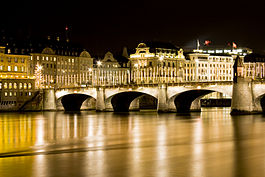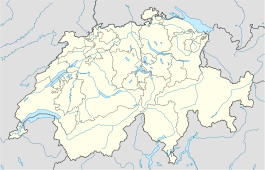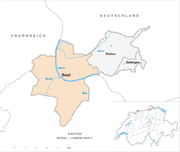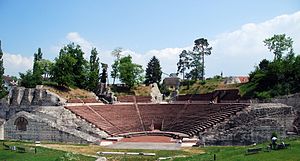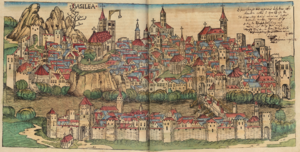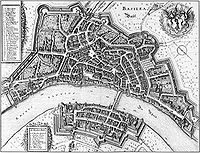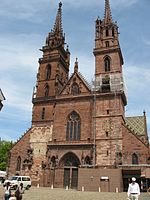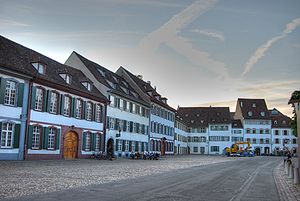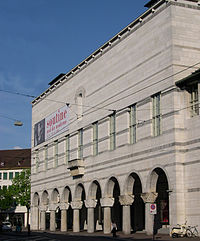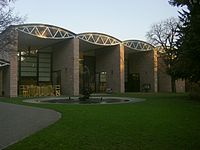
Basel
Did you know...
This selection is made for schools by a children's charity read more. Sponsoring children helps children in the developing world to learn too.
| Basel | ||||||||||
|---|---|---|---|---|---|---|---|---|---|---|
|
||||||||||
| Population | 170,635 (Mar 2012) | |||||||||
| - Density | 7,500 /km2 (19,426 /sq mi) | |||||||||
| Area | 23.91 km2 (9.23 sq mi) | |||||||||
| Elevation | 260 m (853 ft) | |||||||||
| • Lowest | 244.75 m - Rhine shore, national border at Kleinhüningen | |||||||||
| Postal code | 4000 | |||||||||
| SFOS number | 2701 | |||||||||
| Mayor | Guy Morin(as of 2008) GP | |||||||||
| Demonym | Basler | |||||||||
| Surrounded by | Allschwil (BL), Binningen (BL), Birsfelden (BL), Bottmingen (BL), Huningue (FR-68), Münchenstein (BL), Muttenz (BL), Reinach (BL), Riehen, Saint-Louis (FR-68), Weil am Rhein (DE-BW) | |||||||||
| Website | www.basel.ch SFSO statistics |
|||||||||
Basel English pronunciation: /ˈbɑːzəl/ or Basle /ˈbɑːl/ (German: Basel, pronounced [ˈbaːzəl]; French: Bâle [bɑl]; Italian: Basilea [baziˈlɛːa]; Romansh: Basilea [baziˈlɛːa]) is Switzerland's third most populous city with 166,209 inhabitants. Being located where the Swiss, French and German borders meet, Basel also has suburbs in France and Germany. With 830,000 inhabitants in the tri-national metropolitan area as of 2004, Basel is Switzerland's second-largest urban area.
Located in northwest Switzerland on the river Rhine, Basel functions as a major industrial centre for the chemical and pharmaceutical industry. The Basel region, culturally extending into German Baden-Württemberg and French Alsace, reflects the heritage of its three states in the modern Latin name: "Regio TriRhena". It has the oldest university of the Swiss Confederation (1460).
Basel is German-speaking. The local variant of the Swiss German dialects is called Basel German.
History
During the days of the Roman Empire, the settlement of Augusta Raurica was founded 10 or 20 kilometres upstream of present Basel, and a castle was built on the hill overlooking the river where the Basel Münster now stands. But even older Celtic settlements (including a vitrified fort) have been discovered recently in the area predating the Roman castle. The city's position on the Rhine long emphasised its importance: Basel for many centuries possessed the only bridge over the river "between Lake Constance and the sea".
The town of Basel was called Basilea or Basilia in Latin (from Ancient Greek Vasilèa, Βασιλεια meaning kingship) and this name is documented from 374 AD. Since the donation of the Abbey Moutier-Grandvalto and all its possessions to Bishop Adalbero II in 999 till the Reformation, Basel was ruled by prince-bishops (see Bishop of Basel, whose memory is preserved in the crosier shown on the Basel coat-of-arms - see above). In 1019 the construction of the cathedral of Basel (known locally as the Münster) began under German Emperor Heinrich II. In 1225–1226 the Bridge over the Rhine was constructed by Bishop Heinrich von Thun and lesser Basel (Kleinbasel) founded as a beachhead to protect the bridge.
In 1356 the Basel earthquake destroyed much of the city along with a number of castles in the vicinity. The city offered courts to nobles as an alternative to rebuilding their castles, in exchange for the nobles' military protection of the city.
In 1412 (or earlier) the well-known guesthouse Zum Goldenen Sternen was established. Basel became the focal point of western Christendom during the 15th century Council of Basel (1431–1449), including the 1439 election of antipope Felix V. In 1459 Pope Pius II endowed the University of Basel where such notables as Erasmus of Rotterdam and Paracelsus later taught. At the same time the new craft of printing was introduced to Basel by apprentices of Johann Gutenberg.
The Schwabe publishing house was founded in 1488 by Johannes Petri and is the oldest publishing house still in business. Johann Froben also operated his printing house in Basel and was notable for publishing works by Erasmus. In 1495, Basel was incorporated in the Upper Rhenish Imperial Circle; the Bishop of Basel was added to the Bench of the Ecclesiastical Princes. In 1500 the construction of the Basel Münster was finished.
In 1501 Basel joined the Swiss Confederation as its eleventh canton, separating de facto from the Holy Roman Empire, and began the construction of the city council building. The bishop's seat remained in Basel until 1529, when the city became Protestant under Oecolampadius. The bishop's crook was however retained as the city's coat of arms. The first edition of Christianae religionis institutio ( Institutes of the Christian Religion - John Calvin's great exposition of Calvinist doctrine) was published at Basel in March 1536.
In 1543 De humani corporis fabrica, the first book on human anatomy, was published and printed in Basel by Andreas Vesalius (1514–1564).
There are indications Joachim Meyer, author of the influential 16th century martial arts text Kunst des Fechten ("The Art of Fighting") came from Basel. In 1662 the Amerbaschsches Kabinett was established in Basel as the first public museum of art. Its collection became the core of the later Basel Museum of Art.
In 1792 the Republic of Rauracia, a revolutionary French client republic, was created. It lasted until 1793. After three years of political agitation and a short civil war in 1833 the disadvantaged countryside seceded from the Canton of Basel, forming the half canton of Basel-Landschaft.
On July 3, 1874 Switzerland's first zoo (the Zoo Basel) opened its doors in the south of the city towards Binningen.
Basel as international meeting place
Basel has often been the site of peace negotiations and other international meetings. The Treaty of Basel (1499) ended the Swabian War. Two years later Basel joined the Swiss Confederation. The Peace of Basel in 1795 between the French Republic and Prussia and Spain ended the First Coalition against France during the French Revolutionary Wars. In more recent times, the World Zionist Organization held its first congress in Basel on September 3, 1897. Because of the Balkan Wars, the Second International held an extraordinary congress at Basel in 1912. In 1989, the Basel Convention was opened for signature with the aim of preventing the export of hazardous waste from wealthy to developing nations for disposal.
Economy
An annual Federal Swiss trade fair (Mustermesse) takes place in Kleinbasel on the right bank of the Rhine. Other important trade shows include " BaselWorld" (watches and jewelry), Art Basel, Orbit and Cultura.
The Swiss chemical industry operates largely from Basel, and Basel also has a large pharmaceutical industry. Novartis, Syngenta, Ciba Specialty Chemicals, Clariant, Hoffmann-La Roche, and Basilea Pharmaceutica headquartered there. Pharmaceuticals and specialty chemicals have become the modern focus of the city's industrial production. Some of the chemical industry's most notable creations include DDT, Araldite, Valium, Rohypnol and LSD.
UBS AG maintains central offices in Basel, giving finance a pivotal role in the local economy. The importance of banking began when the Bank for International Settlements located within the city in 1930. Basel's innovative financial industry includes institutions like the Basel Committee on Banking Supervision. Responsible for the Basel Accords ( Basel I and Basel II), this organization fundamentally changed Risk Management within its industry.
Basel has Switzerland's tallest building, Basler Messeturm.
Basel also houses the Bank for International Settlements (BIS) and is the central banker's bank. The bank is controlled by a board of directors, which is composed of the elite central bankers of 11 different countries (U.S., UK, Belgium, Canada, France, Germany, Italy, Japan, Switzerland, the Netherlands and Sweden).
Created in 1930, the BIS is owned by its member central banks, which are private entities. No agent of the Swiss public authorities may enter the premises without the express consent of the bank. The bank exercises supervision and police power over its premises. The bank enjoys immunity from criminal and administrative jurisdiction, as well as sets recommendations which become standard for the world's commercial banking system.
Swiss International Air Lines, the national airline of Switzerland, is headquartered on the grounds of EuroAirport Basel-Mulhouse-Freiburg in Saint-Louis, Haut-Rhin, France, near Basel. Prior to the formation of Swiss International Air Lines, the regional airline Crossair was headquartered near Basel.
Quarters
Basel is subdivided into 19 quarters (Quartiere). The municipalities of Riehen and Bettingen, outside the city limits of Basel, are included in the canton of Basel-City as rural quarters (Landquartiere).
| Quartier | ha | Quartier | ha |
|---|---|---|---|
| Altstadt Grossbasel (central Grossbasel) | 37.63 | Altstadt Kleinbasel (central Kleinbasel) | 24.21 |
| Vorstädte (Suburbs) | 89.66 | Clara | 23.66 |
| Am Ring | 90.98 | Wettstein | 75.44 |
| Breite | 68.39 | Hirzbrunnen | 305.32 |
| St. Alban | 294.46 | Rosental | 64.33 |
| Gundeldingen | 123.19 | Mattäus | 59.14 |
| Bruderholz | 259.61 | Klybeck | 91.19 |
| Bachletten | 151.39 | Kleinhüningen | 136.11 |
| Gotthelf | 46.62 | City of Basel | 2275.05 |
| Iselin | 109.82 | Riehen | 1086.10 |
| St. Johann | 223.90 | Bettingen | 222.69 |
| Canton of Basel-City | 3583.84 |
Main sights
The red sandstone Münster, one of the foremost late-Romanesque/early Gothic buildings in the Upper Rhine, was badly damaged in the great earthquake of 1356, rebuilt in the fourteenth and fifteenth century, extensively reconstructed in the mid-nineteenth century and further restored in the late twentieth century. A memorial to Erasmus lies inside the Münster. The City Hall from the 16th century is located on the Market Square and is decorated with fine murals on the outer walls and on the walls of the inner court.
Basel is also host to an array of buildings by internationally renowned architects. These include the Beyeler Foundation by Renzo Piano, or the Vitra complex in nearby Weil am Rhein, composed of buildings by architects such as Zaha Hadid (fire station), Frank Gehry ( design museum), Alvaro Siza Vieira (factory building) and Tadao Ando (conference centre). Basel also features buildings by Mario Botta (Jean Tinguely Museum and Bank of International settlements) and Herzog & de Meuron (whose architectural practice is in Basel, and who are best known as the architects of Tate Modern in London). The city received the Wakker Prize in 1996.
Heritage sites
Basel features a great number of heritage sites of national significance. These include the entire Old Town of Basel as well as the following buildings and collections:
- Churches and monasteries
- Basel Münster, St. Albankirche, Kirche St. Antonius, the former Barfüsserkirche, Elisabethenkirche, Klingentalkirche, Leonhardskirche, Martinskirche, Pauluskirche, Peterskirche, Alt Katholische Predigerkirche, Johanneskirche, Theodorskirche (with Early Middle Age gravefield), the Synagogue (1867), the former Kartause (later an orphanage) and the Kleines Klingental (formerly a Dominican monastery).
- Secular buildings
- Haus zum Raben, Dompropstei (Antikenmuseum Basel und Sammlung Ludwig), Goldener Sternen, Seidenhof (with a monument to Rudolf von Habsburg), Kleiner Kirschgarten, Im Vogelsang housing estate, Bruderholzschulhaus, Safranzunft, Schloss Gundeldingen, Brunschwilerhaus, Holsteinerhof, Spiesshof, City Hall, Geltenzunft, Haus Auf Burg (with Paul Sacher), Domhof, Schönes Haus and Schöner Hof, Zerkindenho, Wildtsches Haus, Blaues Haus (Reichensteinerhof), Weisses Haus (Wendelstörferhof), Sandgrube, Bischofshof, Ramsteinerhof, Hohenfirstenhof, Haus zur Mücke, Wohnhaus für alleinstehende Frauen (1928), Feuerschützenhaus, Spalenhof, Lohnhof, Gate of Saint Alban, Gate of Saint John, the city walls with the Letziturm and the inner wall tower, Gate of Spalen, the Hoffmann-La Roche premises, Bürgerspital (1940–45), Basel Badischer Bahnhof with fountain (1913), Basel SBB railway station(1907), Mittlere Rheinbrücke, Fischmarktbrunnen.
- Archaeological sites
- Gallo-Roman settlement on the Gasfabrik premises, Alemannic burial fields Gotterbarmweg and Kleinhüningen, early medieval buildings Schneidergasse 2-16.
- Museums, archives and collections
- State Archives of Basel, Swiss Economic Archives, University library, Antikenmuseum, Art Museum and engravings cabinet, Museum of Contemporary Art, Gallizianmühle, Natural History Museum (with Rütimeyer library), Museum of Cultures, Kirschgartenmuseum, Historical Museum, Jewish Museum, Music Museum, Sport Museum, Sculpture Hall, Anatomical Collection, Stadt-und Münstermuseum (Kleines Klingental), Gewerbemuseum, Pharmazie-Historisches Museum, Caricature and Cartoon Museum, Salvation Army Museum.
Education
Basel hosts Switzerland's oldest university, the University of Basel, dating from 1459. Erasmus, Paracelsus, Daniel Bernoulli, Leonhard Euler, Jacob Burckhardt, and Friedrich Nietzsche worked here. More recently, its work in tropical medicine has gained prominence.
Basel is renowned for various scientific societies, as the Entomological Society of Basel (Entomologische Gesellschaft Basel, EGB), which celebrated its 100th anniversary in 2005.
Basel counts several International Schools, including the International School of Basel, the Minerva School and the Rhine Academy.
Politics
Geo-politically, the city of Basel functions as the capital of the Swiss half-canton of Basel-Stadt, though several of its suburbs form part of the half-canton of Basel-Landschaft or of the canton of Aargau (or of France or Germany).
Weather
| Climate data for Basel/Binningen | |||||||||||||
|---|---|---|---|---|---|---|---|---|---|---|---|---|---|
| Month | Jan | Feb | Mar | Apr | May | Jun | Jul | Aug | Sep | Oct | Nov | Dec | Year |
| Source: MeteoSchweiz | |||||||||||||
Notable residents of Basel
- Karl Barth (1886–1968), Reformed Protestant theologian
- Daniel Bernoulli (1700–1782) mathematician
- James Bernoulli (1654–1705), mathematician
- Johann Bernoulli (1667–1748), mathematician
- Peter Birkhäuser (1911–1976), painter
- Jacob Burckhardt (1818–1897), professor in history, theology, philosophy
- Arthur Cohn (1927- ), film producer
- Erasmus (c1466-1536), biblical scholar, humanist, theologian
- Leonhard Euler (1707–1783), mathematician
- Roger Federer (1981- ), tennis player
- Katy French (1983–2007), model and socialite
- Jakob Emanuel Handmann (1718–1781), painter
- Johann Peter Hebel (1760–1826), poet & author
- Albert Hofmann (1906–2008), chemist, discoverer of LSD
- Carl Gustav Jung (1875–1961), psychiatrist
- Lucius Munatius Plancus (c. 87 BC - c. 15 BC), city founder
- Christoph Merian (1800–1858)
- Joachim Meyer (c. 1537?-1571), fencer and author
- Friedrich Nietzsche (1844–1900), philosopher
- Paracelsus (1493–1541), scientist
- Frithjof Schuon (1907–1998), religious philosopher
- Adrian Sieber (1972- ), Swiss solo singer and lead vocalist in the band Lovebugs.
- Andreas Vesalius (1446), noted anatomist and pioneer of modern medicine.
- Gustav Bertha (1969–present)
Culture
Basel has a reputation as one of the most important cultural cities in Europe. Theatre Basel presents a busy schedule of plays in addition to being home to the city's opera and ballet companies. In 1997, it contended to become the " European Capital of Culture". In May 2004, the fifth European Festival of Youth Choirs (Europäisches Jugendchorfestival, or EJCF) choir festival opened: this Basel tradition started in 1992. Host of this festival is the local Basel Boys Choir.
The carnival of the city of Basel ( Basler Fasnacht) is a major cultural event in the year. The carnival is the biggest in Switzerland and attracts large crowds every year, despite the fact that it starts at four in the morning (Morgestraich) and lasts for exactly 72 hours, taking in various parades.
Basler Zeitung ("Baz") is the local newspaper.
The Zoo Basel is the oldest zoo in Switzerland and a major tourist attraction with over 1.6 million visitors per year. While locals call name the zoo lovingly "Zolli", it is at the same time one, if not the, most visited tourist attraction in Basel.
Basel is host to the Basel Tattoo, started by the Top Secret Drum Corps.
Museums
The Basel museums cover a broad and diverse spectrum of collections with a marked concentration in the fine arts. They house numerous holdings of international significance. The over three dozen institutions yield an extraordinarily high density of museums compared to other cities of similar size and draw over one million visitors annually.
Constituting an essential component of Basel culture and cultural policy, the museums are the result of closely interwoven private and public collecting activities and promotion of arts and culture going back to the 16th century. The public museum collection was first created back in 1661 and represents the oldest public collection in continuous existence. Since the late 1980s, various private collections have been made accessible to the public in new purpose-built structures that have been recognized as acclaimed examples of avant-garde museum architecture.
- Antikenmuseum Basel und Sammlung Ludwig Ancient cultures of the mediterranean museum
- Augusta Raurica Roman open-air museum
- Basel Paper Mill (German: Basler Papiermühle)
- Beyeler Foundation (Fondation Beyeler) Beyeler Museum (Fondation Beyeler)
- Botanical Garden Basel One of the oldest botanical gardens in the world
- Caricature & Cartoon Museum Basel (German: Karikatur & Cartoon Museum Basel)
- Dollhouse Museum (German: Puppenhausmuseum)
- Historical Museum Basel (German: Historisches Museum Basel)
- Kunsthalle Basel Modern and contemporary art museum
- Kunstmuseum Basel Upper Rhenish and Flemish paintings, drawings from 1400 to 1600 and 19th- to 21st-century art
- Monteverdi Automuseum
- Museum of Cultures Basel (German: Museum der Kulturen Basel) Large collections on European and non-Europeancultural life
- Museum of Contemporary Art Art from the 1960s up to the present
- Music Museum (German: Musikmuseum) of the Basel Historic Museum
- Natural History Museum of Basel (German: Naturhistorisches Museum Basel)
- Pharmazie-Historisches Museum der Universität Basel
- Puppenhausmuseum - a museum houring the largest teddy bear collection in Europe.
- Schaulager Modern and contemporary art museum
- Swiss Architecture Museum (German: Schweizerisches Architekturmuseum)
- Tinguely Museum Life and work of the major Swiss iron sculptor Jean Tinguely
- Vitra Design Museum Museum in Weil am Rhein near Basel
